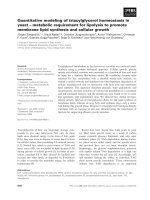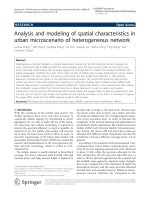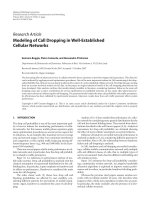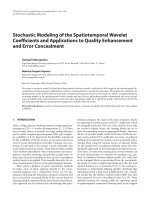Stochastic modeling of the number of trees and the number of felled trees in selection stands
Bạn đang xem bản rút gọn của tài liệu. Xem và tải ngay bản đầy đủ của tài liệu tại đây (209.29 KB, 8 trang )
Yugoslav Journal of Operations Research
14 (2004), Number 1, 57-64
STOCHASTIC MODELING OF THE NUMBER OF TREES
AND THE NUMBER OF FELLED TREES IN SELECTION
STANDS*
Slobodanka S. MITROVIĆ
Faculty of Forestry
University of Belgrade
Belgrade, Serbia and Montenegro
Received: July 2002 / Accepted: September 2003
Abstract: This paper solves the problem of forecasting the number of trees in the
selection stands predicted for harvesting in a future period, so that the present resource of
the number of trees is sustained. This is achieved by stochastic modeling of the number
of trees and the number of felled trees and by solving the partial differential equation.
Keywords: Random walk, Itô´s lemma, lognormal distribution, Itô´s stochastic differential
equation, partial differential equation.
1. INTRODUCTION
The number of trees in selection stands naturally increases in time. If the
conditions were ideal, if there were no natural or artificial (due to an anthropogenic
impact) removals of trees, the increase would be exponential in the time from t0 to t, i.e.
the dependence would be:
µ (t – t0)
x(t) = x0 · e
(1)
where x(t) is the number of trees in the selection stand per hectare depending on time t; µ
is the factor of constant growth, x0 is the initial number of trees in the stand at the
moment t0 .
Let S(x,t) be the number of felled trees, i.e. the planned impact of the
anthropogenic factor on the number of trees x in the selection stand. There is a problem
how to organise and limit the number of trees for felling in a time period t = T, without
* 2000 Mathematics Subject Classification: 60H15, 35Q80, 91B76.
58
S. Mitrović / Stochastic Modeling of the Number of Trees
disturbing the present resources. In other words, the question is what capacity of the
number of trees in the selection stand can be counted on and planned for harvesting at a
definite future moment, so as to maintain the present number of trees in the stand. The
significance of the problem is manifold: environmental and economic, bearing in mind
that taking care of environmental conditions results in long-term economic gains.
In this paper, the dependencies x(t) and S(x,t) are modeled by Itô´s stochastic
differential equations and the distribution for the random process x(t) is given. Then the
decision on the allowable cut is based on the requirement that the ratio of the changed
number of trees in the selection stand and the changed number of felled trees is balanced.
This is achieved by solving the derived partial differential equation of the second order,
with two boundary and one final condition.
2. MODELING THE NUMBER OF TREES IN THE STAND
dx(t )
of x(t) > 0 in a short time interval, we
x(t )
may conclude that it is broken down into the predictable, deterministic part and the
random part, with white noise in its base. This is the standard way to explain many
natural processes of growth. In other words, the continuous random process x(t) can be
represented by Itô´s stochastic differential equation:
If we observe a relative change
dx = µx dt + σx dw,
(2)
where µ is the drift, the expected rate of return, σ is the volatility, the measure of
standard deviation, and w is the standard Wiener process. The first term in the above
relation is deterministic and the second one is characterised by the presence of the
Wiener process as the carrier of randomness. If σ = 0 (there were no removals of trees in
selection stand), from the differential equation dx = µxdt, we can easily get the solution
(1) for the process x.
Assume that µ and σ are constants in the definite time period. The parameters
µ and σ are given in time units, mainly for a year. Often, µ is not changeable for one
kind of selection stand. In the spatial model they are taken to be constant values,
previously determined by statistical methods based on field data (look at statistical data
from [3]).
For the standard Wiener process we take:
dw = z t ,
where z ∈ N(0,1). Hence, the expected value E(dw) = 0, and the variance D(dw) = dt,
and:
E(dx) = E(µx dt + σx dw) = µx dt , D(dx) = E(σ2x2dw2) = σ2x2dt.
In the case of discrete time with known µ and σ, we can simulate the process x by:
∆x = µx ∆ t + σx z ∆t .
S. Mitrović / Stochastic Modeling of the Number of Trees
59
Example. Assume that the initial value is x(t0) = x0 = 10, the drift is 5%, (µ = 0.05), and
the standard deviation is 20%, (σ = 0.2) by year, ∆t = 1. Then
∆x = (0.05 + 0.2 z) · x .
For 9 realised (casually chosen) values of the stochastic variable z, we get the table:
Table 1.
x
10
10.15
13.59
12.01
15.76
14.37
14.48
18.01
14.84
16.62
z
-0.175
1.44
-0.83
1.31
-0.69
-0.21
0.97
-1.13
0.35
- 0.47
∆x
0.15
3.43
- 1.58
3.75
-1.39
0.11
3.53
- 3.17
1.78
- 0.73
At the end of simulation we read the value x = 16.62 – 0.73 = 15.89, from the last row,
which is valid for x(t) after 10 years.
3. DISTRIBUTION OF STOCHASTIC PROCESS x(t)
Let f be a smooth function of x and t, where the process x is given by (2), then
applying Itô´s lemma, we have:
df =
1
∂f
∂f
∂f
∂2 f
dt + µx
dt + σx dw + σ2x2 2 dt ,
∂t
∂x
∂x
∂x
2
(see [1]). For f(x) = ln x, it is:
df = (µ –
1 2
σ ) dt + σ dw ,
2
with solution:
f = f0 + (µ –
1 2
σ ) (t – t0) + σ(w(t) – w(t0)).
2
Specially, for t0 = 0, w(t0) = 0, x(0) = x0 , we have:
ln x – ln x0 = (µ –
1 2
σ ) t + σ w(t) ,
2
S. Mitrović / Stochastic Modeling of the Number of Trees
60
Now, from that we conclude ln
E( ln
x
) = (µ –
x0
x
has a normal distribution with:
x0
1 2
σ ) t,
2
D( ln
x
) = σ2t .
x0
x
has a lognormal distribution with density:
x0
It means that
(ln
x0
σ x 2π t
exp(–
x
1
− ( µ − σ 2 )t ) 2
x0
2
),
2
2σ t
x > 0.
4. REQUIREMENT DERIVATIVES
As S(x,t) depends on x(t), t > 0, let us suppose that the dependence is expressed
∂S ∂S
∂2 S
by a continuous function with continuous partial derivations
,
and
. Then by
∂t ∂x
∂x 2
applying Itô´s lemma:
dS =
∂S
∂S
dt +
dx +
∂t
∂x
1 2 2 ∂2 S
σx
dt ,
∂x 2
2
By this we get the stochastic differential equation of random walk, which
represents the process of the number of felled trees.
Let us consider the relation S(x,t) and x(t), by introducing a new function, the
requirement Π:
Π = S – Ω · x,
∂S
is chosen (rate of change S(x,t) compared to x(t)). Such an interpretation
∂x
of Ω in this model, aims at neutralising the stochastic component in the following step.
From the natural assumption that in a short time interval dt, the number of trees in the
selection stand is not disturbed and that the ratio of the number of trees and the number
of felled trees is constant, we get:
where Ω =
dΠ = dS – Ω · dx = dS –
= (
∂S
+
∂t
∂S
∂S
∂S
dx =
dt +
dx +
∂x
∂t
∂x
1 2 2 ∂2 S
σx
) dt = 0.
∂x 2
2
1 2 2 ∂2 S
∂S
σx
dt–
dx =
2
∂x
∂x
2
Therefore:
∂S
+
∂t
1 2 2 ∂2 S
σx
= 0,
∂x 2
2
(3)
S. Mitrović / Stochastic Modeling of the Number of Trees
61
and the determination of S(x,t) means the solution of (3), a linear partial differential
equation of the second order PDE, parabolic type. To be solved, it should be transformed
into the canonical form, with set boundary conditions and a final condition.
First, if for a t, x(t) = 0, then also from (2), dx = 0, i.e. x(t) is an invariable
µ (t – t0)
process. This means that σ = 0, and from x(t) = x0 · e
therefore:
, for x0 = 0, we get x(t) = 0,
S(0, t) = 0 .
(4)
On the other hand it is clear that:
S(x, t) ≈ x ,
(5)
when x increases, i.e. when x tends to ∞ . These are boundary conditions.
Finally, we have to determine the final condition. If the felling was performed at
the moment t0, after which x(t) was measured, then the next future number of felled trees
will depend on that number of trees in the stand x0 and the number of trees in future time
T, i.e. there will be a difference between the future theoretical number (the maximal
number which would be realised in ideal conditions) and the initial number of trees in the
stand:
µ (T – t0 )
x(T )
S(x, T) = x(T) – x(t0) = x(t0) · (
– 1) = x0 · ( e
–1).
(6)
x(t0 )
for PDE.
It is clear that for T > t0 and µ > 0, S(x,T) > 0. Condition (6) is the final condition
5. SOLVING PDE
First, we have to transform PDE (3) in the canonical form taking a function u:
u(y, τ) = S(x, t),
where y = ln x , and τ =
1 2
σ (T– t). According to partial derivations:
2
∂S
1 ∂u
= – σ2
,
∂t
2 ∂τ
∂S
1 ∂u
=
·
,
∂x
x ∂y
∂2 S
1 ∂u
1 ∂ 2u
=– 2 ·
+ 2 · 2 ,
2
∂x
x ∂y
x ∂y
we have the new PDE, for – ∞ < y < ∞:
∂u
∂u
∂ 2u
+
– 2 = 0,
∂τ
∂y
∂y
with the boundary conditions u(–∞, τ) = 0 , and u( ∞, τ) = ∞ .
Now, we choose the next form of u(y, τ):
αy+βτ
u(y , τ) = e
taking α =
v(y, τ),
1
1
, β = – . Putting the derivatives
2
4
(7)
S. Mitrović / Stochastic Modeling of the Number of Trees
62
1
1
1
1
1
1
y− τ
y− τ
∂u
∂v 2 y − 4τ ∂u
1
1
∂v
∂ 2u
1
∂v ∂ 2 v
=(– v+
)e
,
=( v+ ) e 2 4 , 2 =( v + + 2 ) e 2 4
∂τ
∂y
∂y ∂y
4 ∂τ
2 ∂y
4
∂y
into the previous equation, we have finally PDE in canonical form:
∂v
∂2v
= 2,
∂τ
∂y
– ∞ < y < ∞, τ > 0.
(8)
It is well known that the solution of PDE (8), called diffusion equation, is:
v(y, τ) =
∞
1
∫ v0 ( p)e
2 πτ
− ( y − p )2
4τ
dp ,
−∞
(see [4, 5]), where the function v0(y) is the beginning condition given by the final
condition (6), and u(y, 0) = S(x, T), for τ = 0:
µ (T – t0 )
v 0(y) = v(y, 0) = e − y / 2 u(y, 0) = e− y / 2 · ec · ( e
where c = ln x0 .
Taking
v(y, τ) =
p− y
2τ
1
2π
–1 )
= q, we get:
∞
∫
v0 (q 2τ + y )e
− q2
2
dq .
−∞
According to (9), the integral is:
v(y, τ) =
=
=
=
=
∞
1
2π
1
2π
1
2π
1
2π
1
2π
∫
e
1
q2
− ( q 2τ + y ) − + c
2
2
(e µ (T −t0 ) − 1)dq
y
−
2τ
-y/2 + c
e
(e
µ (T–t0 )
∞
∫
–1)
µ (T-t0)
–1) e
µ (T-t0)
–1) e
∞
∫
µ (T - t0 )
e
–1) e
1
1
− ( q + 2τ ) 2
2
2
2τ
∞
1 1
− y+ τ +c
2 4
dq
y
1 1
− y+ τ +c
2 4
−
(e
dq
2τ
1 1
− y+ τ +c
2 4
−
(e
1
1
τ
− ( q + 2τ ) 2 +
2
2
4
y
−
(e
e
∫1
y
2τ
+
2
d
∫
−∞
e
e
1
− r2
2
2τ
1
− r2
2
dr .
dr
(9)
S. Mitrović / Stochastic Modeling of the Number of Trees
63
So,
v(y, τ) = e
where d =
y
2τ
Hence, from (7)
–
1 1
− y+ τ +c
2 4
1
2
1
u(y, τ) = e 2
where d =
· (e
µ (T – t0)
– 1) · N(d),
2τ , and N is the function of normal distribution.
1
y− τ
4
· e
1 1
− y+ τ +c
2 4
ln x − σ 2 (T − t ) / 2
σ T −t
(e
µ (T - t0)
c µ (T - t0)
– 1 ) · N(d) = e ( e
– 1 ) · N(d) .
. Finally, we get the explicit expression for S(x, t) in time
T:
S(x, T) = x0 · ( e
µ (T - t0)
– 1 ) · N(d) ,
(10)
which represents the maximal number of wood allowed to cut in time T. The value of
N(d) usually equals to one. In the case of very small x, it is less than one.
Note. If T – t = 0, then N(d) = 1, and the formulas (6) and (10) are the same.
6. EXAMPLES
Based on statistical data measured in the Management Unit "Tara" - National
Park "Tara", Bajina Basta, Serbia, between 1960 and 1990, several times the number of
felled trees amounted up to even 20% of the number of trees in the stand. Also, by
comparing only the numbers of trees in the stand in a ten-year period, it was calculated
that these values were statistically equal (see [3]), which leads to a conclusion that the
method of selection forests management applied in the forests of Tara in the past decades
was relatively successful. In other words, the initial resource of the number of trees was
maintained, and the quantity selected for felling was only the percentage that
accumulated during ten years, like an "interest".
Example. Let us take x(t) = 100, expected rate of return µ = 0.02, and volatility or
measure of standard deviation σ = 0.2, by year, and T - t = 10 years. Then,
d=
ln100 − 0.22 ⋅10 / 2
0.2 10
= 6.965,
and the forecast for S(x, T) by (10):
N(6.965) = 1,
S(x, T) = 22.14.
Example. In 1970, the number of trees in the selection stand, Compartment 51,
Management Unit "Tara", was x(t) = 557.4. The number of trees per hectare is not integer
number. On the same sample plot in 1980 the number of felled trees was 109.1, (see [3])
64
S. Mitrović / Stochastic Modeling of the Number of Trees
which is less than the maximal number of trees selected for felling, calculated by
theoretical means.
Namely, if we take the expected rate of return µ = 0.02, standard deviation σ = 0.2, and
ln 557.4 − 0.22 ⋅10 / 2
T – t = 10 years, then d =
= 9.68, N(9.68) = 1, and for S(x, T) we
0.2 10
get:
S(x, T) = 123.41 .
Example. In 1960, the number of trees in the selection stand, Compartment 62,
Management Unit "Tara", was x(t) = 664.0. On the same sample plot in 1970 the number
of felled trees was 126.4, (see [3]) which is less than the maximal number of trees
selected for felling, calculated by theoretical means.
Namely, if we take the expected rate of return µ = 0.02, standard deviation σ = 0.2, and
ln 664 − 0.22 ⋅10 / 2
T – t = 10 years, then, d =
= 9.96, N(9.96) = 1, and for S(x, T) we
0.2 10
get:
S(x, T) = 147.01.
The above examples point out that the field data on the number of felled trees,
correspond completely to the theoretical upper boundaries. This means that the calculated
forecast (10) for S(x,T) can also be applied in future for the assessment of the upper
permissible limit of the number of trees for felling.
REFERENCES
[1]
[2]
[3]
[4]
[5]
Black, F., and Scholes, M. "The pricing of options and corporate liabilities", Journal of
Political Economy, 81 (3) (1973) 637-659.
Itô, K., On Stochastic Differential Equations, Memorial Mathematical Society, 1951, 1-51.
Mitrović, S., Banković, S., "The possibilities of using group regression in the analysis of the
diameter structure development in selection forests of Tara", University of Belgrade, Bulletin
of the Faculty of Forestry, 85 (2002) 79-90 (in Serbian).
Steele, J., M., Stochastic Calculus and Financial Applications, Spinger-Verlag, New York,
2001.
Wilmott, P., Howison, S., and Dewynne, J., Mathematics of Financial Derivatives, Cambridge
University Press, 1995.









